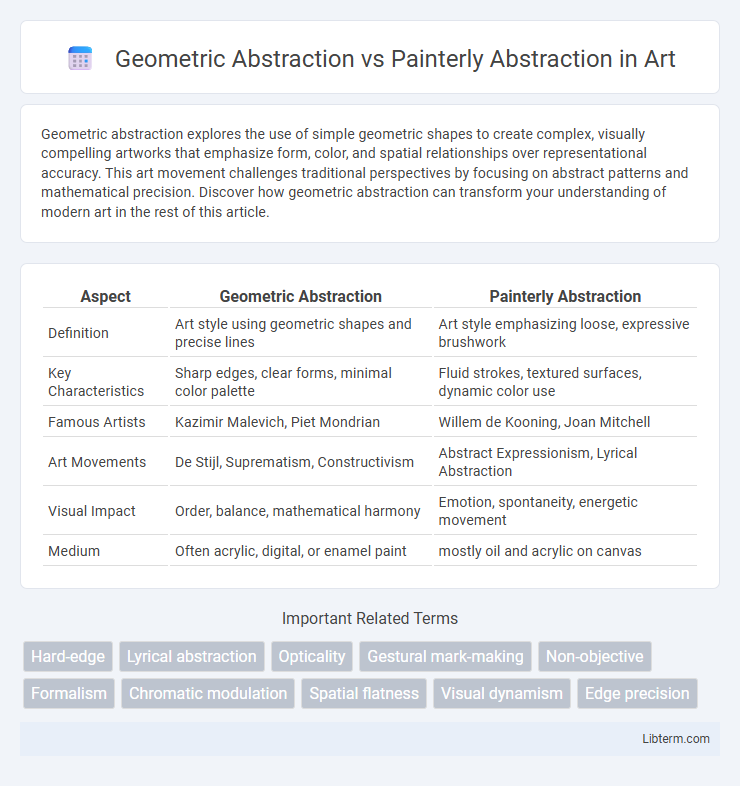Geometric abstraction explores the use of simple geometric shapes to create complex, visually compelling artworks that emphasize form, color, and spatial relationships over representational accuracy. This art movement challenges traditional perspectives by focusing on abstract patterns and mathematical precision. Discover how geometric abstraction can transform your understanding of modern art in the rest of this article.
Table of Comparison
| Aspect | Geometric Abstraction | Painterly Abstraction |
|---|---|---|
| Definition | Art style using geometric shapes and precise lines | Art style emphasizing loose, expressive brushwork |
| Key Characteristics | Sharp edges, clear forms, minimal color palette | Fluid strokes, textured surfaces, dynamic color use |
| Famous Artists | Kazimir Malevich, Piet Mondrian | Willem de Kooning, Joan Mitchell |
| Art Movements | De Stijl, Suprematism, Constructivism | Abstract Expressionism, Lyrical Abstraction |
| Visual Impact | Order, balance, mathematical harmony | Emotion, spontaneity, energetic movement |
| Medium | Often acrylic, digital, or enamel paint | mostly oil and acrylic on canvas |
Defining Geometric Abstraction
Geometric Abstraction is defined by the use of precise, mathematical shapes such as squares, circles, and triangles to create non-representational compositions emphasizing order and clarity. This style often employs clean lines, symmetry, and a limited color palette to highlight structure and form rather than emotional expression. Contrasting with Painterly Abstraction, Geometric Abstraction minimizes visible brushstrokes and texture to maintain a sense of objectivity and visual harmony.
Understanding Painterly Abstraction
Painterly Abstraction emphasizes visible brushstrokes, texture, and expressive use of color to convey emotion and spontaneity, contrasting with the precise forms found in Geometric Abstraction. It often features irregular shapes and dynamic compositions that prioritize the physicality of paint and the artist's gesture. This style invites viewers to experience the process of creation and the tactile qualities of the medium rather than focusing on strict geometry or clear structure.
Historical Roots of Both Movements
Geometric Abstraction emerged in the early 20th century, rooted in the avant-garde movements such as Cubism and Suprematism, emphasizing precise shapes, mathematical order, and non-representational forms. Painterly Abstraction developed concurrently, influenced by Expressionism and Impressionism, characterized by loose, dynamic brushstrokes and an emphasis on texture and spontaneity. Both movements reflect divergent responses to modernity, with Geometric Abstraction prioritizing structure and clarity, while Painterly Abstraction embraces emotional expression and visual fluidity.
Key Philosophies and Inspirations
Geometric Abstraction emphasizes precision, order, and the use of mathematical forms, deriving inspiration from Cubism, Constructivism, and the quest for universal visual language. Painterly Abstraction prioritizes expressive brushwork, texture, and emotional spontaneity, drawing influence from Abstract Expressionism and the artist's inner psyche. Both philosophies challenge traditional representation but diverge in their methods--one through structured geometry, the other through fluid gesture.
Techniques and Materials Used
Geometric Abstraction relies on precise shapes, clean lines, and often uses materials like acrylic paint or digital media to achieve sharp edges and uniform surfaces, emphasizing mathematical forms and spatial relationships. Painterly Abstraction emphasizes visible brushstrokes, texture, and layering techniques, frequently using oil paints or mixed media to create expressive, dynamic compositions with a tactile quality. Techniques in Painterly Abstraction involve gestural application and blending, contrasting with the controlled and methodical approach characteristic of Geometric Abstraction.
Prominent Artists in Geometric Abstraction
Prominent artists in Geometric Abstraction include Piet Mondrian, known for his grid-based compositions with primary colors, and Kazimir Malevich, founder of Suprematism emphasizing basic geometric forms. Josef Albers contributed significantly with his exploration of color interaction and precise geometric shapes in his "Homage to the Square" series. These artists prioritized structure, order, and simplicity, contrasting with the more fluid and expressive brushwork characteristic of Painterly Abstraction.
Influential Figures in Painterly Abstraction
Painterly abstraction is characterized by expressive brushstrokes and a focus on texture and emotion, distinguishing it from the precise forms of geometric abstraction. Influential figures in painterly abstraction include Willem de Kooning, known for his vigorous brushwork and dynamic compositions, and Arshile Gorky, whose work bridges surrealism and abstract expressionism with fluid, organic forms. These artists emphasized spontaneity and emotional intensity, shaping the trajectory of abstract art in the mid-20th century.
Visual Impact and Audience Perception
Geometric Abstraction employs precise shapes and clear lines, creating a structured visual impact that emphasizes order and clarity, often evoking intellectual engagement from the audience. Painterly Abstraction, characterized by expressive brushstrokes and fluid forms, generates a dynamic and emotional visual experience that invites subjective interpretation. Audience perception of Geometric Abstraction tends to focus on harmony and balance, while Painterly Abstraction appeals through spontaneity and emotional intensity.
Contemporary Developments in Both Styles
Geometric abstraction in contemporary art emphasizes precise shapes, sharp lines, and mathematical forms, often integrating digital techniques and algorithmic generation to enhance visual complexity and spatial depth. Painterly abstraction embraces expressive brushwork, textural richness, and fluid forms, with artists exploring mixed media and innovative pigment applications to convey emotion and organic movement. Both styles increasingly intersect with installation art and augmented reality, expanding traditional boundaries and engaging viewers in multisensory experiences.
Geometric vs Painterly: Artistic Legacy and Influence
Geometric abstraction, characterized by precise shapes, clean lines, and mathematical clarity, has profoundly influenced modernist movements such as Bauhaus and De Stijl, emphasizing order and rationality in art. Painterly abstraction, with its expressive brushwork, fluid forms, and emotional intensity, draws heavily from Impressionism and Abstract Expressionism, highlighting spontaneity and the artist's personal gesture. The contrast between these styles shapes artistic legacy by balancing structured formality with emotive freedom, impacting contemporary art's exploration of space and expression.
Geometric Abstraction Infographic

 libterm.com
libterm.com